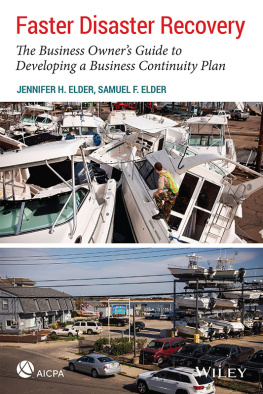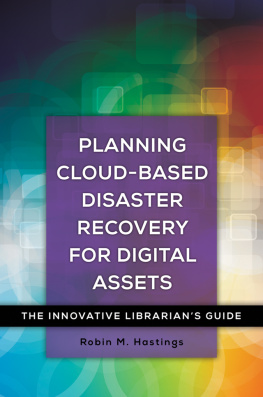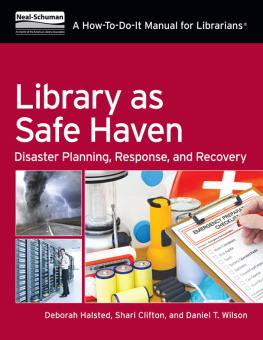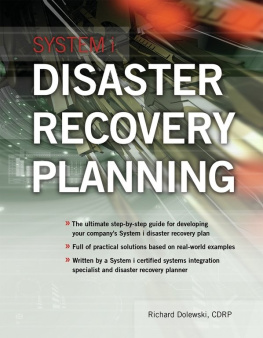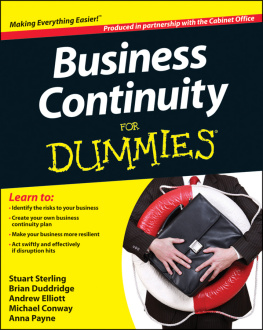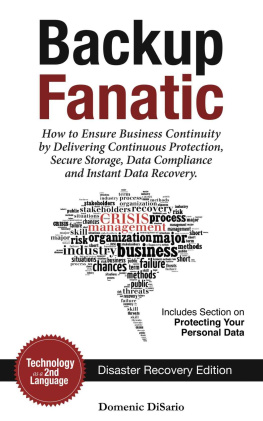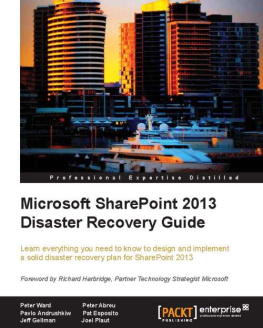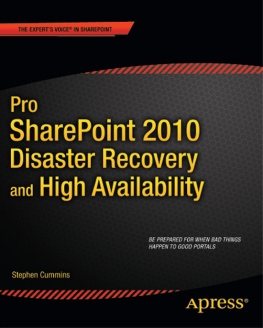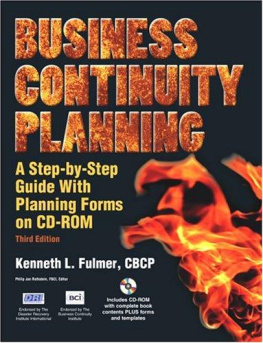
Faster Disaster Recovery
The Business Owner's Guide
to Developing a Business
Continuity Plan
Jennifer H. Elder
Samuel F. Elder
Cover image: Andrew Burton/Staff/Getty Images
Cover design: Wiley
Copyright 2019 by Association of International Certified Professional Accountants. All rights reserved.
Published by John Wiley & Sons, Inc., Hoboken, New Jersey.
Published simultaneously in Canada.
No part of this publication may be reproduced, stored in a retrieval system, or transmitted in any form or by any means, electronic, mechanical, photocopying, recording, scanning, or otherwise, except as permitted under Section 107 or 108 of the 1976 United States Copyright Act, without either the prior written permission of the Publisher, or authorization through payment of the appropriate per-copy fee to the Copyright Clearance Center, Inc., 222 Rosewood Drive, Danvers, MA 01923, (978) 750-8400, fax (978) 646-8600, or on the Web at www.copyright.com. Requests to the Publisher for permission should be addressed to the Permissions Department, John Wiley & Sons, Inc., 111 River Street, Hoboken, NJ 07030, (201) 748-6011, fax (201) 748-6008, or online at www.wiley.com/go/permissions.
Limit of Liability/Disclaimer of Warranty: While the publisher and author have used their best efforts in preparing this book, they make no representations or warranties with respect to the accuracy or completeness of the contents of this book and specifically disclaim any implied warranties of merchantability or fitness for a particular purpose. No warranty may be created or extended by sales representatives or written sales materials. The advice and strategies contained herein may not be suitable for your situation. You should consult with a professional where appropriate. Neither the publisher nor author shall be liable for any loss of profit or any other commercial damages, including but not limited to special, incidental, consequential, or other damages.
For general information on our other products and services or for technical support, please contact our Customer Care Department within the United States at (800) 762-2974, outside the United States at (317) 572-3993, or fax (317) 572-4002.
Wiley publishes in a variety of print and electronic formats and by print-on-demand. Some material included with standard print versions of this book may not be included in e-books or in print-on-demand. If this book refers to media such as a CD or DVD that is not included in the version you purchased, you may download this material at http://booksupport.wiley.com. For more information about Wiley products, visit www.wiley.com.
ISBN 978-1-119-57096-7 (Paperback)
ISBN 978-1-119-57102-5 (ePDF)
ISBN 978-1-119-57094-3 (ePub)
This book is dedicated to our families. Thank you, Brian
and Eunice Howard, Judith Mernick, Gaynor Sorrell,
Dr. Samuel and Sandra Elder, Susan Alders, and
Chris Elder. Without your wisdom, advice, and support,
we would never have survived the disasters!
Preface
Every year, disasters, emergencies, and disruptive events take a toll on organizations around the world. They cost money and lives and, too often, organizations never recover.
Although we may not be able to do anything to stop a natural disaster or keep the most sophisticated hackers from attempting to steal our confidential information and trade secrets, there are many steps an organization can take to reduce (and even prevent) damage, enabling them to perform business as usual.
Certainly, a disaster can be created by a massive event, such as a hurricane, fire, or terrorist attack, but it can also be triggered by smaller events, such as a power outage, cyberattack, or even road construction.
And in many cases, disastrous events can be predicted and the extent of their impact expected. For instance, hurricanes like Superstorm Sandy (which hit the East Coast in October 2012), Hurricane Maria (which hit the Caribbean and Puerto Rico in 2017), or Hurricane Harvey (which hit Texas in 2017 and caused $125 billion in damage, mostly in Houston), are often tracked and monitored as they develop.
Although Superstorm Sandy was predicted, no one expected that power would be out for 9 to 12 weeks in many areas of New York and New Jersey. And Hurricane Maria was predicted, but the effect was not something many businesses were prepared to handle. How do you open your store if your employees cannot get to work? How do you find employees when many of the island residents decide to relocate to another country? How do you open your manufacturing facility if you are without power for six months? Would your business survive?
However, although some disasters can be foreseen by experts, they are often overlooked by businesses and organizations. If your organization is located near a bridge, for example, have you ever considered the impact of a closure?
According to a 2018 report by the American Road and Transportation Builder's Association, 54,259 of the bridges in the United States are rated structurally deficient. And one in three bridges have identified repair needs. It only makes sense that if a bridge is known to be structurally deficient before a disaster, the disaster is likely to make it worse, maybe even totally destroying it. This can greatly impact your company, as one business owner in Maryland learned the hard way.
This particular woman was a veterinarian who lived on one side of a small, two-lane bridge; her practice was on the other. One day, the bridge failed unexpectedly, closing it for nine months for repairs and turning her normal five-minute drive to work to a full 45-minute nightmare.
While she personally found this annoying, she discovered that her customers found it impossible, largely because they didn't want to subject their sick pets to a longer car ride, especially in the event of an emergency. As a result, her revenue dropped by a greater percentage each month the bridge was closed. Ultimately, she wound up losing 30 percent of her annual revenue... and many of her loyal customers.
Admittedly, this same disaster may not have the same impact on every organization, as what may be an annoyance for one can be a crisis for another. For instance, your computer servers going down is likely to be bothersome, but if you have a bank or brokerage, you may never recover from such a disaster.
Additionally, a winter storm bringing three feet of snow may have no impact on an organization if the employees can work virtually from home, but how do hospitals function if their employees can't get to work? What happens then?
Aside from additional expenses and lost revenue, another often-overlooked impact of a disaster is reputational loss. Your hard-earned, stellar reputation for reliability and dependability can be permanently damaged if you're unable to react quickly to a disaster and address the needs of customers and employees.
That's why this book existsto help business owners like you protect your company's reputation as well as your finances in the event of a disaster. Each chapter discusses a different area of disaster planning of a business continuity process. At the end of each chapter is Questions to Ask Yourself to help you apply what you learn to your organization.
NOTE
.
CHAPTER 1
Business Disaster Defined
How do you define a disaster? What about a business disaster? Is it different? Or is it the same?
Next page
